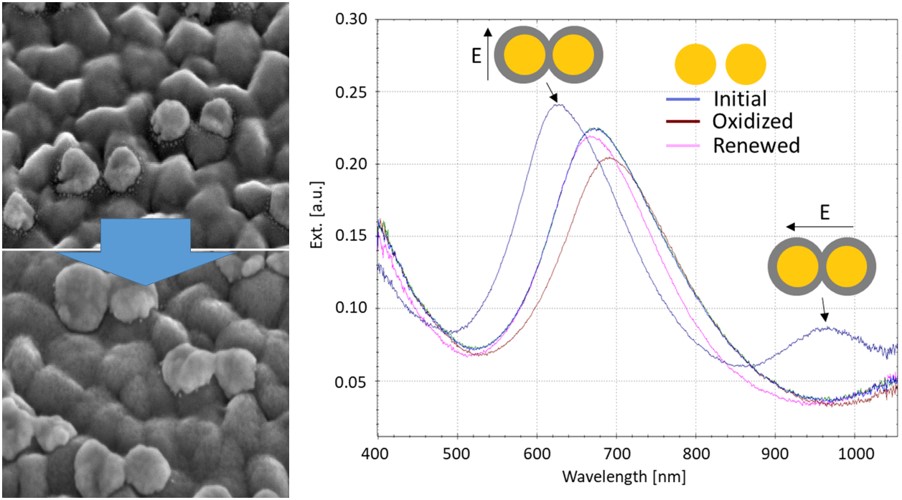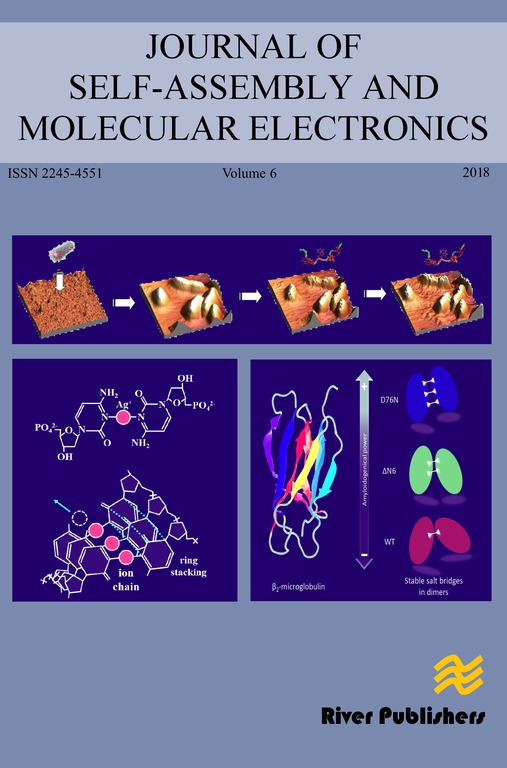Dynamic Modulation of Plasmonic Structures
DOI:
https://doi.org/10.13052/jsame2245-4551.7.001Keywords:
Nanofabrication, active plasmonics, silver electrodeposition, gold nanoparticles, hole-mask colloidal lithography.Abstract
A method for active switching of plasmonic structures by surface oxide-
stabilized silver deposition is presented. The longitudinal dipole mode in pairs
of closely spaced gold nanodisks on ITO was switched by depositing and
removing a connecting layer of silver in solution. Optical properties were
studied using VIS-NIR extinction spectroscopy and confirmed by FDTD
simulations. Uniform dimensional growth by selective silver deposition
brought pairs of gold nanodisks of 73 nm average diameter and 11 nm
average distance into electrical contact. The growth process was studied by
spectroelectrochemical measurements, and uniformity and selectivity were
confirmed by SEM and XPS analysis, respectively. Uniform deposition was
achieved by introduction of surface oxides on immobilized gold nanodisks,
and selectivity by undervoltage deposition. Deposition of silver on disk pairs
caused a blue-shift of the transverse dipole mode resonance of roughly 50 nm,
and emergence of a new longitudinal mode with resonance around 960 nm.
These results demonstrate the possibility for not only tuning of resonance
peak position, but also on-demand switching of an additional mode which can
provide materials with switchable optical properties.
Downloads
References
E. de Harven, R. Leung, and H. Christensen, “A novel approach for
scanning electron microscopy of colloidal gold-labeled cell surfaces.,”
J. Cell Biol., vol. 99, no. 1 Pt 1, pp. 53–7, Jul. 1984.
L. Seopsi, L.-I. Larsson, L. Bastholm, and M. H. Nielsen, “Silver-
enhanced colloidal gold probes as markers for scanning electron
microscopy,” Histochemistry, vol. 86, no. 1, pp. 35–41, 1986.
I. H. El-Sayed, X. Huang, and M. A. El-Sayed, “Surface Plasmon Res-
onance Scattering and Absorption of anti-EGFR Antibody Conjugated
Gold Nanoparticles in Cancer Diagnostics: Applications in Oral Cancer,”
T. Gong, D. Goh, M. Olivo, and K.-T. Yong, “In vitro toxicity and
bioimaging studies of gold nanorods formulations coated with biofunc-
tional thiol-PEG molecules and Pluronic block copolymers,” Beilstein
J. Nanotechnol, vol. 5, pp. 546–553, 2014.
P. Ciaurriz, F. Fernández, E. Tellechea, J. F. Moran, and A. C. Asensio,
“Comparison of four functionalization methods of gold nanoparticles for
enhancing the enzyme-linked immunosorbent assay (ELISA).,” Beilstein
J. Nanotechnol., vol. 8, pp. 244–253, 2017.
J. Su, Z. Zhou, H. Li, and S. Liu, “Quantitative detection of human
chorionic gonadotropin antigen via immunogold chromatographic test
strips,” 2014.
S. V. Boriskina and B. M. Reinhard, “Molding the flow of light on
the nanoscale: from vortex nanogears to phase-operated plasmonic
machinery,” Nanoscale, vol. 4, no. 1, pp. 76–90, Dec. 2012.
E. Hutter and J. H. Fendler, “Exploitation of localized surface plasmon
resonance,” Adv. Mater., vol. 16, no. 19, pp. 1685–1706, 2004.
E. M. Larsson, J. Alegret, M. Ka, and D. S. Sutherland, “Sensing
Characteristics of NIR Localized Surface Plasmon Resonances in Gold
Nanorings for Application as Ultrasensitive Biosensors,” 2007.
“The investigation of an LSPR refractive index sensor based on periodic
gold nanorings array,” 2018.
M. Li, S. K. Cushing, and N. Wu, “Plasmon-Enhanced Optical Sensors:
A Review.”
M. Kang, J.-J. Kim, Y.-J. Oh, S.-G. Park, and K.-H. Jeong,
“A Deformable Nanoplasmonic Membrane Reveals Universal Corre-
lations Between Plasmon Resonance and Surface Enhanced Raman
Scattering,” Adv. Mater., vol. 26, no. 26, pp. 4510–4514, Jul. 2014.
H. Dyrnesli et al.
C. P. Byers et al., “From tunable core-shell nanoparticles to plasmonic
drawbridges: Active control of nanoparticle optical properties,” Sci. Adv.,
vol. 1, no. 11, pp. e1500988–e1500988, Dec. 2015.
M. Chirea, S. S. E. Collins, X. Wei, and P. Mulvaney, “Spectroelectro-
chemistry of Silver Deposition on Single Gold Nanocrystals,” J. Phys.
Chem. Lett, vol. 5, p. 35, 2014.
M. Frederiksen and D. S. Sutherland, “Direct modification of colloidal
hole-masks for locally ordered hetero-assemblies of nanostructures over
large areas,” Nanoscale, vol. 6, no. 2, pp. 731–735, Dec. 2014.
P. B. Johnson and R. W. Christy, “Optical Constants of the Noble Metals,”
Phys. Rev. B, vol. 6, no. 12, pp. 4370–4379, Dec. 1972.
T. A. F. König et al., “Electrically Tunable Plasmonic Behavior of
Nanocube–Polymer Nanomaterials Induced by a Redox-Active Elec-
trochromic Polymer,” ACS Nano, vol. 8, no. 6, pp. 6182–6192, Jun.
J. Cao, T. Sun, and K. T. V. Grattan, “Gold nanorod-based localized
surface plasmon resonance biosensors: A review,” Sensors Actuators B
Chem., vol. 195, pp. 332–351, May 2014.
E. Prodan, C. Radloff, N. J. Halas, and P. Nordlander, “A Hybridization
Model for the Plasmon Response of Complex Nanostructures,” Science
(80-.)., vol. 302, no. 5644, pp. 419–422, Oct. 2003.
* Per Hanarp, and Mikael K ̈all, and D. S. Sutherland, “Optical Properties
of Short Range Ordered Arrays of Nanometer Gold Disks Prepared by
Colloidal Lithography,” 2003.
P. Nordlander, C. Oubre, E. Prodan, K. Li, and M. I. Stockman, “Plasmon
Hybridization in Nanoparticle Dimers,” vol. 14, p. 44, 2018.
V. Myroshnychenko et al., “Modelling the optical response of gold
nanoparticles,” Chem. Soc. Rev., vol. 37, no. 9, p. 1792, Aug. 2008.
N. Zohar, L. Chuntonov, and G. Haran, “The simplest plasmonic
molecules: Metal nanoparticle dimers and trimers,” J. Photochem.
Photobiol. C Photochem. Rev., vol. 21, pp. 26–39, 2014.
D. Zhang and Y. Tang, “Enhancing light reflective properties on ITO
glass by plasmonic effect of silver nanoparticles,” Results Phys., vol. 7,
pp. 2874–2877, Jan. 2017.
Y. Feng et al., “Uniform Large-Area Free-Standing Silver Nanowire
Arrays on Transparent Conducting Substrates,” J. Electrochem. Soc.,
vol. 163, no. 8, pp. D447–D452, Jun. 2016.
R. Sivasubramanian and M. V. Sangaranarayanan, “A facile formation
of silver dendrites on indium tin oxide surfaces using electrodeposition
Dynamic Modulation of Plasmonic Structures 19
and amperometric sensing of hydrazine,” Sensors Actuators B Chem.,
vol. 213, pp. 92–101, Jul. 2015.
D. Hern ́andez-Santos, M. Gonz ́alez-Garc ́ıa, and A. Costa-Garc ́ıa, “Elec-
trochemical determination of gold nanoparticles in colloidal solutions,”
Electrochim. Acta, vol. 46, no. 4, pp. 607–615, Dec. 2000.
C. S. Holgate, P. Jackson, P. N. Cowen, and C. C. Bird, “The Journal of
Histochemistry and Cytochemistry Immunogold-Silver Staining: New
Method of Immunostaining with Enhanced Sensitivity’,” 1983.
A. Corma and H. Garcia, “Supported gold nanoparticles as catalysts for
organic reactionsw,” 2008.
D. V Jawale et al., “Size effect of gold nanoparticles supported on carbon
nanotube as catalysts in selected organic reactions,” Tetrahedron, vol. 70,
pp. 6140–6145, 2014.
P. Suchomel et al., “Simple size-controlled synthesis of Au nanoparticles
and their size-dependent catalytic activity OPEN.”
W. E. Benet, G. S. Lewis, L. Z. Yang, and P. D. E. Hughes, “The
mechanism of the reaction of the Tollens reagent,” J. Chem. Res., vol.
, no. 12, pp. 675–677, Dec. 2011.
T. Ung, M. Giersig, D. Dunstan, and P. Mulvaney, “Spectroelectrochem-
istry of Colloidal Silver,” 1997.
A. B. Dahlin et al., “Electrochemical plasmonic sensors,” Anal. Bioanal.
Chem., vol. 402, no. 5, pp. 1773–1784, Feb. 2012.
G. Gonçalves, E. Elangovan, P. Barquinha, L. Pereira, R. Martins, and
E. Fortunato, “Influence of post-annealing temperature on the properties
exhibited by ITO, IZO and GZO thin films,” Thin Solid Films, vol. 515,
no. 24, pp. 8562–8566, Oct. 2007




